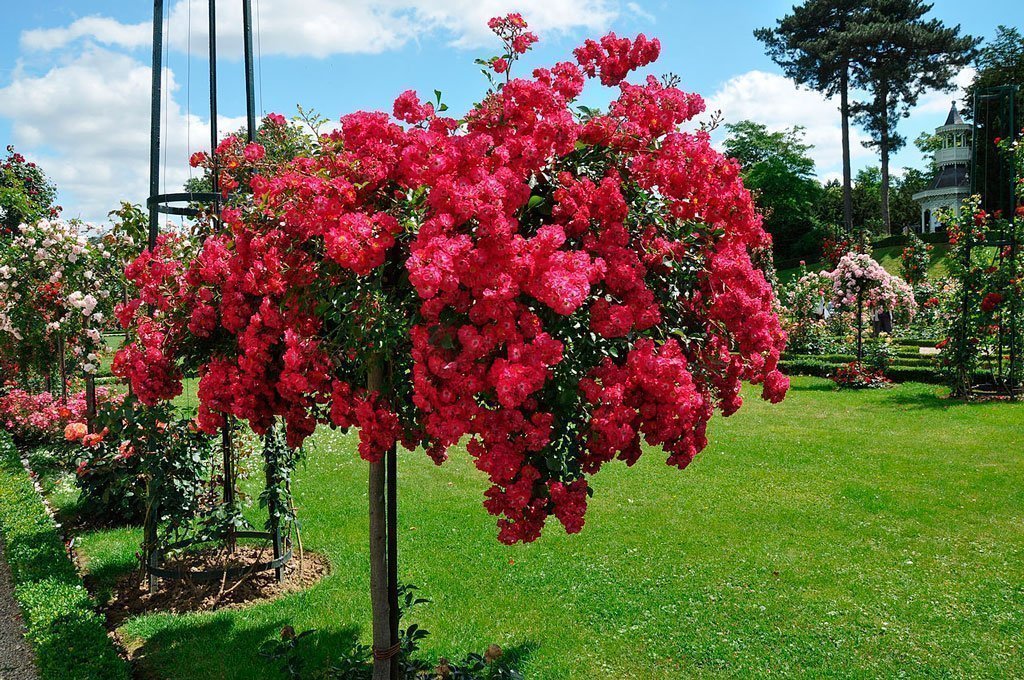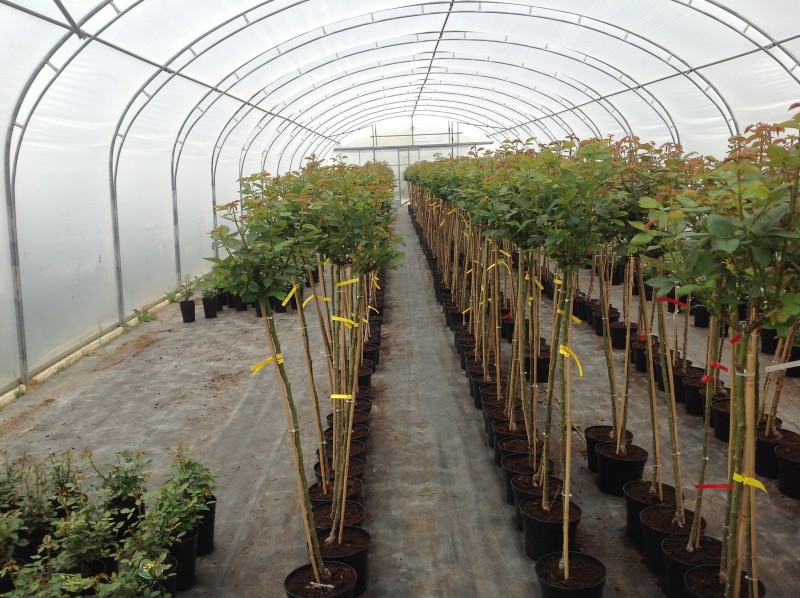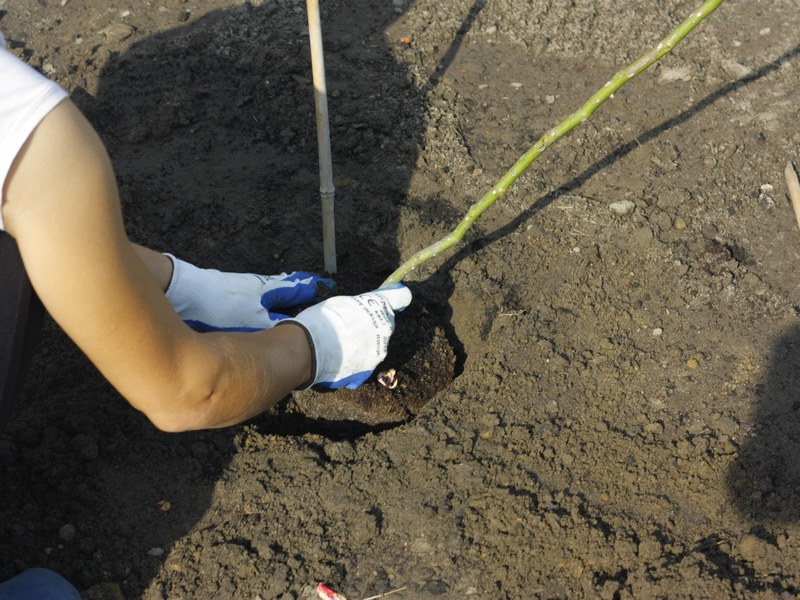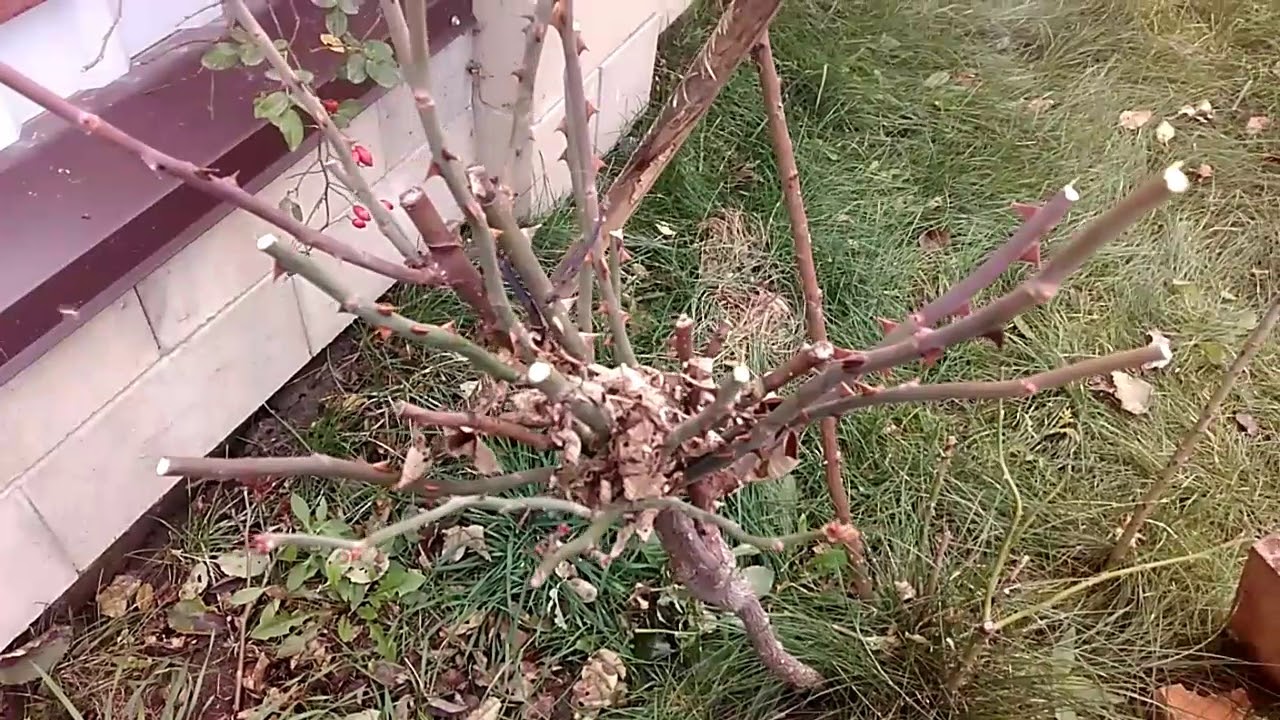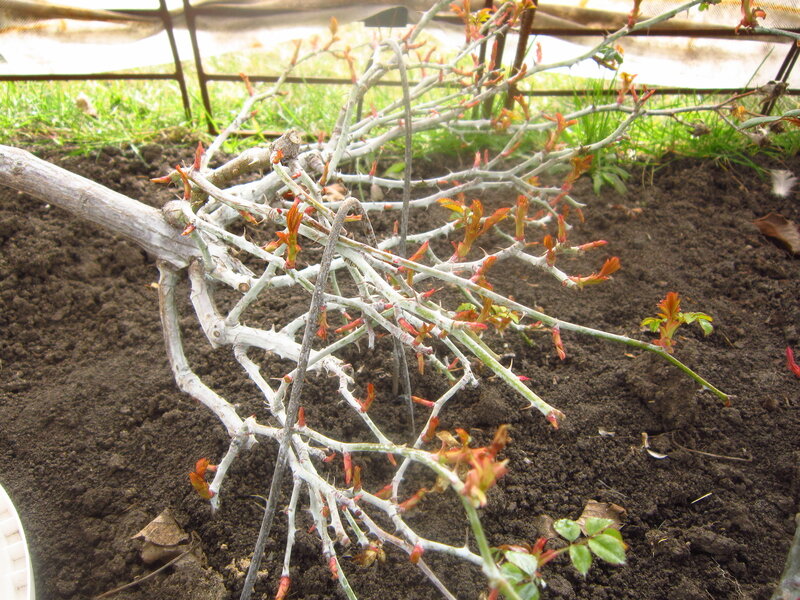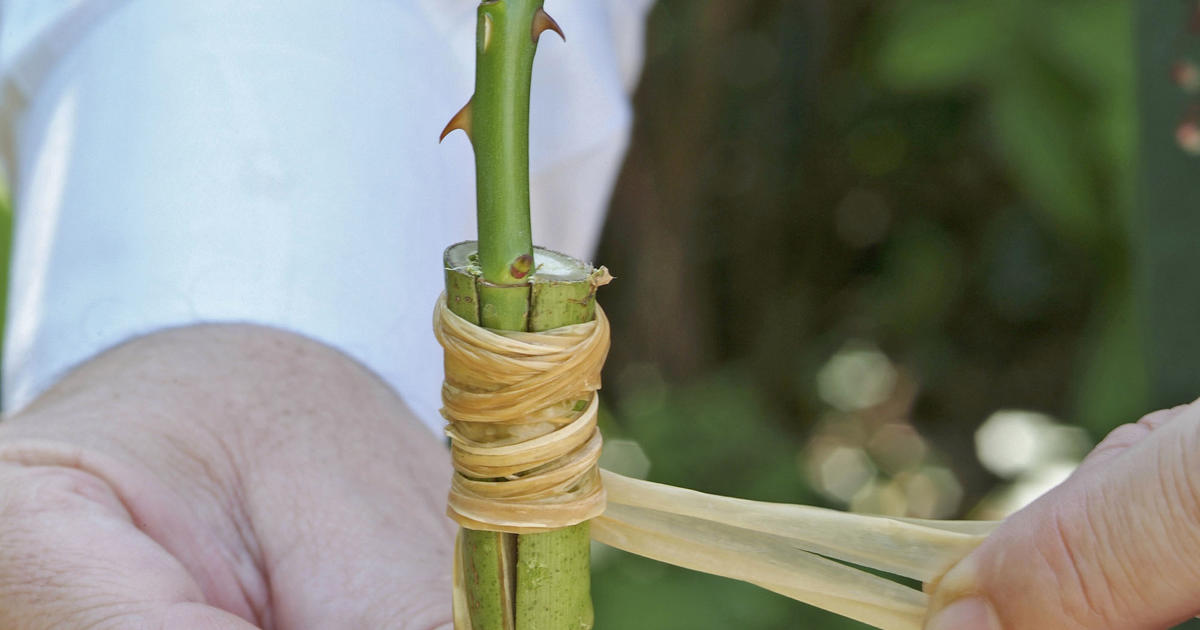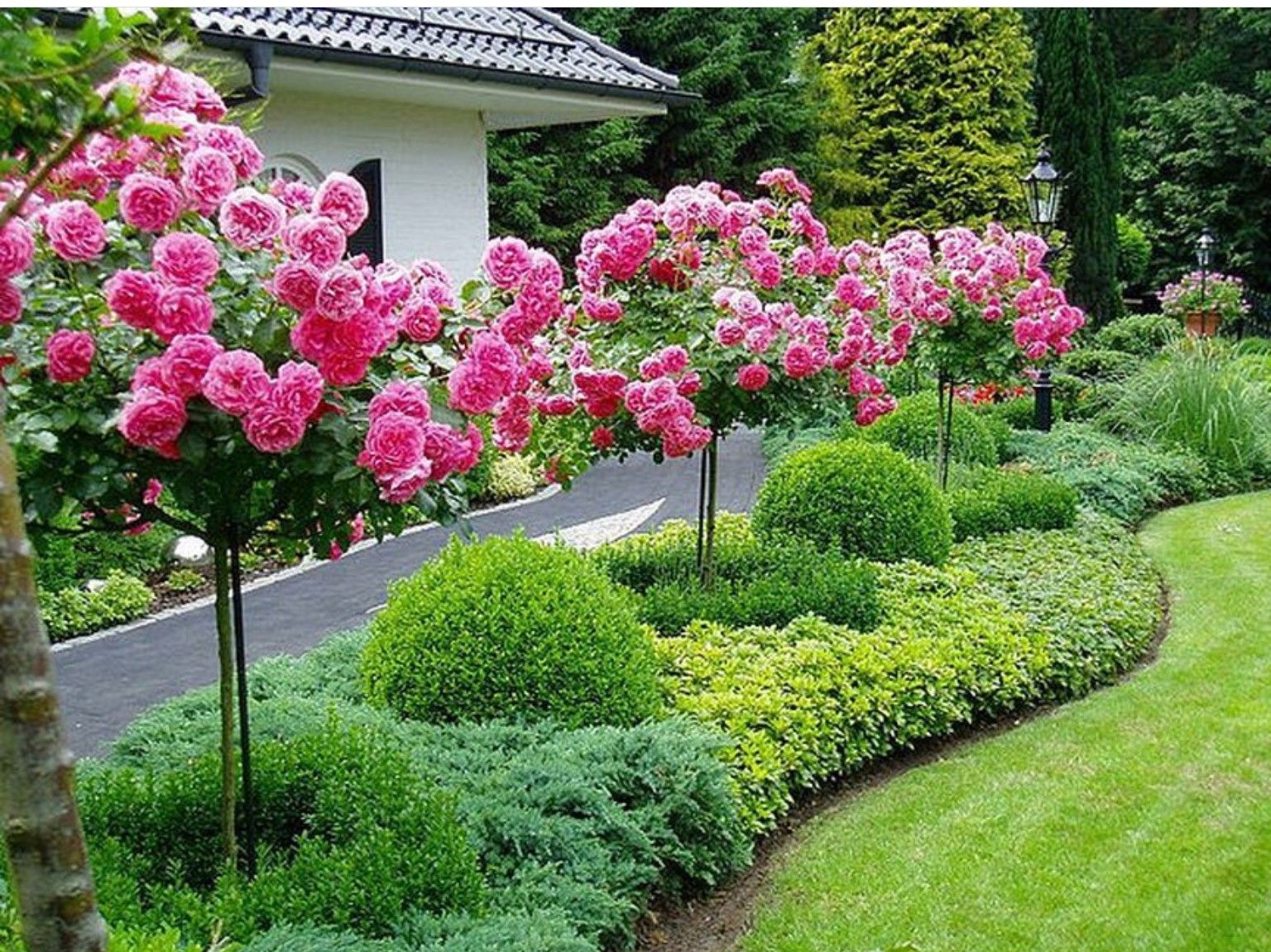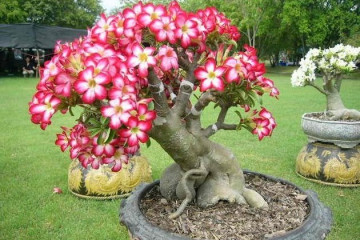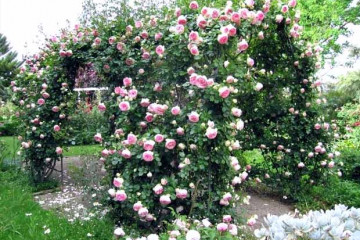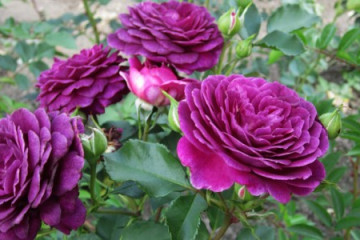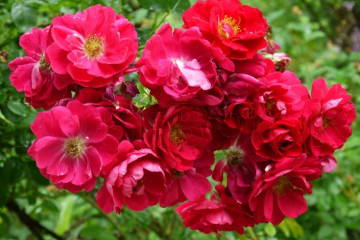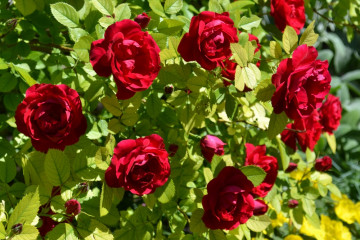Standard rose: description, planting, care, landscape design with roses
Content:
Standard roses are spectacular plants that are gaining more and more popularity. They can be grown as a pot culture (for decorating loggias and patios) and outdoors, creating compositions from single or group plantings.
Description of standard roses
Why is the plant called that? A rose on a trunk is a tree with a bare trunk and a lush crown. The plant consists of two parts: rootstock and scion. The root system and stem belong to the wild-growing species of roses (most often the rose hips). The crown is represented by a cultivated rose grafted into the upper part of the rootstock. The refinement of a rounded or weeping crown shape is achieved as a result of annual pruning.
Plant features
Most often, hybrid tea varieties and floribunda varieties are used to create the upper part of the standard rose. Weeping crown forms are created using cascading shoots of climbing varieties.
Standard roses are subdivided:
- miniature forms - the length of the stem is 40-50 cm, dwarf roses are used as a scion;
- half-stubs - 60-70 cm high, with floribunda roses grafting;
- classic shape - stick height 90-130 cm, with a crown of varieties of hybrid tea roses;
- weeping (cascading) form - the height of the trunk is 1.2-1.7 m, climbing and ground cover roses are used.
Advantages and disadvantages of standard roses
Advantages of tree-shaped roses:
- high aesthetics;
- early and lush bloom;
- the ability to create multi-tiered compositions.
Disadvantages of standard plants:
- exactingness to care;
- poor survival rate in a new place;
- the difficulty of trimming;
- high cost of seedlings.
It will take time and some skill to plant a tree yourself.
Growing a rose yourself: step by step instructions
Stamp rose is a spectacular plant that is not easy to obtain. Many gardeners fear that they will not be able to grow the tree on their own. In fact, every flower lover can do it. It is important to choose a good seedling, plant it correctly, master the nuances of pruning, garters and shelters for the winter.
Sapling selection
Cuttings of standard roses should be purchased from specialized nurseries, where they can provide plants with high-quality rootstocks and professionally vaccinated. It is preferable to buy seedlings with a closed root system at the age of 2 years.
The diameter of the stem should be at least 1-2 cm. The branches of the scion are light green without signs of wilting, rot and mold. The seedling should be carefully examined: at least two grafts should be in the upper part of the rootstock, otherwise the crown will not be lush enough. The stamp should be even, straight, without cracks, the stock and the scion are tightly spliced.
Landing dates
In mid-latitudes, planting roses is best done in spring, when the daily air temperature reaches + 10 ° С, the soil warms up to + 15 ° С. Autumn planting justifies itself only in the southern regions.In areas with a temperate climate, the event often ends in failure - the tree does not have time to take root and freezes out.
Site selection and soil preparation
Roses are planted on the south side of the site with sufficient illumination and protection from the north winds. The place should be ventilated, but not in a draft.
Lowlands, areas with stagnant moisture and close groundwater are not suitable for growing boles. Roses thrive on light, breathable, fertile, slightly acidic (pH 6-7) soils. When planting, you should immediately provide for the availability of a place for laying the plant for the winter.
Landing technology
Step-by-step instructions for planting a plant in open ground:
- The landing pit is prepared in advance. When planting several plants, maintain a distance of at least 1 m. Dig a hole 60 × 70 cm in size, lay expanded clay drainage on the bottom, fill the hole with planting mixture.
- The substrate is prepared from compost, the top fertile soil layer and sand in a ratio of 2: 3: 1. When growing a standard rose in apartments, pots are selected with a diameter of at least 25 cm, a height of 30 cm.
- The root system of the seedling is soaked for a day in a growth stimulator. Light root shoots are cut off before planting.
- The stalk is placed in a planting pit, straightening the root system. The stem of the tree is positioned at an angle of 45 ° towards the root bend. When planting, make sure that the root collar is 2-3 cm below the soil level.
- A wooden stake is stuck in the opposite side of the slope, the tree is tied up.
- The soil in the near-trunk circle is tamped, making a small depression so that the water does not drain off during watering.
- The plant is watered abundantly. The soil in the near-trunk circle is mulched with sawdust or crushed bark.
Rules for caring for standard roses
Planting and caring for a standard rose in the open field is more difficult than for ordinary bushes. A formed tree is more difficult to cut. The junction of the rootstock and the scion must be constantly monitored, when cracks and signs of decay appear, remove diseased areas and cover up the damage with garden varnish.
Watering and feeding
After planting, you need to keep the soil moist for 2 weeks, water it daily, making sure that a soil crust does not form. In the future, the flower is abundantly watered with warm, settled water every 2-3 days. Up to 20 liters of liquid are poured under an adult tree in summer. Rose is a moisture-loving plant that does not tolerate the drying out of an earthen coma. With a lack of moisture, the flowers begin to shrink. Bushes develop well with drip irrigation, but do not tolerate sprinkling.
Roses are fed three times per season:
- in spring - during the period of leaf blooming, fertilizers are used: 20 g of ammonium nitrate and 20 g of potassium salt per 10 liters of water;
- in summer - when plants begin to bloom, use organic or complex mineral fertilizers;
- in autumn - in September, phosphate-potassium dressings are used.
During the summer, foliar dressing is carried out on foliage with fertilizer solutions: "Kemira Lux", "Solution", potassium humate.
Loosening
The trees should be looked after regularly. The soil under the bushes is loosened weekly to a depth of 3-4 cm, providing the roots of roses with oxygen and preventing decay of the root system. The rose garden is regularly freed from weeds.Grass depletes the soil, serves as a source of fungal diseases and pests.
Pruning and shaping the bush
To perform the event, a sharp pruner and a lopper are prepared. Pruning of a standard rose is carried out twice a year: in spring and autumn.
Spring pruning involves the removal of root growth and crown formation. Trimming the upper part of the trunk has the goal of giving the branched part of the tree the correct shape. Shoots of floribunda roses and hybrid tea types are pruned to 5 buds, more drastic pruning weakens flowering. In climbing roses, skeletal shoots that faded last year are cut out, and the shoots of the current year are slightly shortened. During the season, wilted flowers are regularly removed - this stimulates bud formation.
The original support is replaced with a permanent one made of metal or durable plastic. Bamboo can be used but is less durable. The branches of the crown are tied to the support with a soft elastic material. The trunk is fixed in place just below the graft.
Protection against diseases and pests
Standard roses can get sick with chlorosis, spots. In wet rainy years, plants are affected by powdery mildew and gray rot. In the spring and summer, preventive treatments are carried out with a 3% solution of Bordeaux mixture. Spraying with "Fitosporin" is carried out every 10-14 days during the entire growing season. For severe lesions, fungicides are used: iron vitriol, Tiovit Jet, Skor.
Young shoots of a flower are often struck by green and black aphids; leaf-gnawing caterpillars, scale insects, thrips can be found on the bushes. For prevention, you can use funds - "Aktara", "BI-58 New". If pests are found, the plants are sprayed with Agat and Quadris insecticides.
Shelter for the winter
Preparation of bushes for wintering begins when the average daily temperatures reach + 5 ° C. Unripe shoots are cut off, the remaining branches are shortened, the fallen leaves are removed. The trunk is disconnected from the support, the tree is buried on one side and laid on a layer of spruce branches. When the nighttime temperatures drop to -5-7 ° C, the upper part is covered with burlap or spunbond, the base of the stem is spud up. In winter, the rose is sprinkled with snow as an additional cover.
In areas where frequent and prolonged thaws occur in winter (Moscow region), an air shelter provides a guaranteed successful wintering. Arcs are placed over the bent tree, the structure is covered with agrofiber, and a layer of polyethylene is pulled on top.
Shelter is removed in April. This is done gradually, opening the plants for several hours. Bright sun rays can cause severe burns.
How to propagate a standard rose
To grow a rose on a stem with your own hands is possible, but you need to take into account that the process will take about 7 years. Rosehip is best suited as a stock. It has a strong root system, is not susceptible to diseases, and has high winter hardiness.
Plants are grown from seeds planted in the fall so that they undergo natural stratification. Seedlings appear in spring. Rosehip can also be propagated by rooting cuttings. The seedlings are grown for 5 years.
Seedlings with a straight and even main shoot are selected. In July, all branches are cut off at the level of the root collar, leaving only the central shoot. It is pinched at a height of 1.2-1.5 m at the end of July.
In mid-August, 2-4 grafts of annual shoots of varietal roses are made on the upper part of the stem. As a scion, shoots of rose varieties zoned in a given area are used. The plant is grafted in two ways:
- Budding.An incision in the shape of the letter "T" is made on the rootstock, and the bud of the cultivated shoot is inserted into the incision. The junction is tightly fixed with tape, only a peephole remains outside. After a month, if the vaccination is successful, the kidney begins to grow.
- Grafting by cuttings. A split is made in the upper part of the stock. An annual cut of a varietal rose is sharpened from below in the form of a wedge and inserted into a split. The junction is wrapped with tape and coated with garden varnish, protecting it from decay, the penetration of pathogens and pests.
In the fall, the plant begins to prepare for wintering. The tree is buried on one side so that it can be gently bent. The stem is laid on a layer of spruce branches and covered with agrofibre. In winter, the tree is additionally covered with snow.
In the spring and summer of next year, the time for the formation of the crown comes. By trimming, a tight, rounded hat is achieved. The buds are pinched in the first summer. The standard rose acquires decorativeness only in the next growing season.
Standard roses in landscape design
Standard roses in garden design will adorn any site. They look great against the backdrop of a lawn framed by dwarf roses and ground cover plants. The stems are planted along paths and paths, used as a tapeworm plant in a mixborder.
Planting of lavender, sage, geranium, ageratum is well combined with a standard rose. Beautiful design elements - decorative cereals fescue, maned barley.
When planning a rosearium, landscape designers create interesting compositions by grouping standard and spray roses of the same color. Roses look great in the frame of conifers - creeping junipers, undersized thuja, mountain pine.
It takes a lot of work to grow a rose on a stem, but the result is worth the effort. With proper cultivation, a tree with a lush crown becomes the main accent of a flower garden, a source of pride for a gardener.

